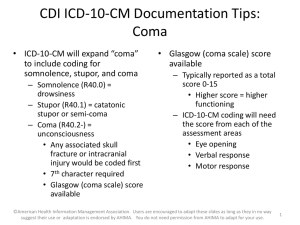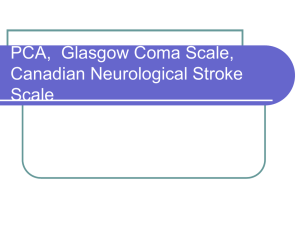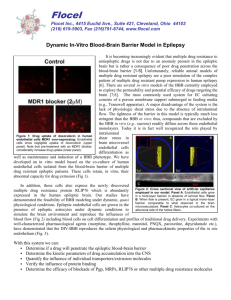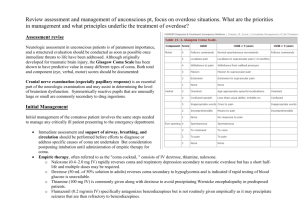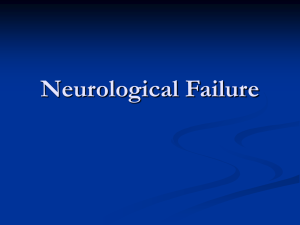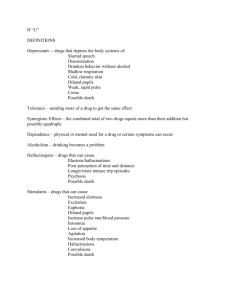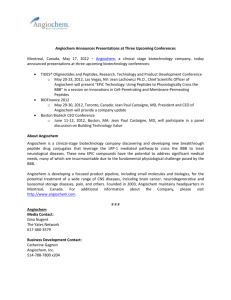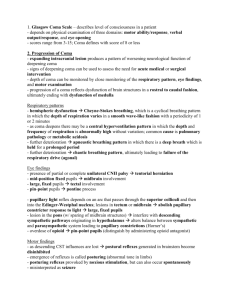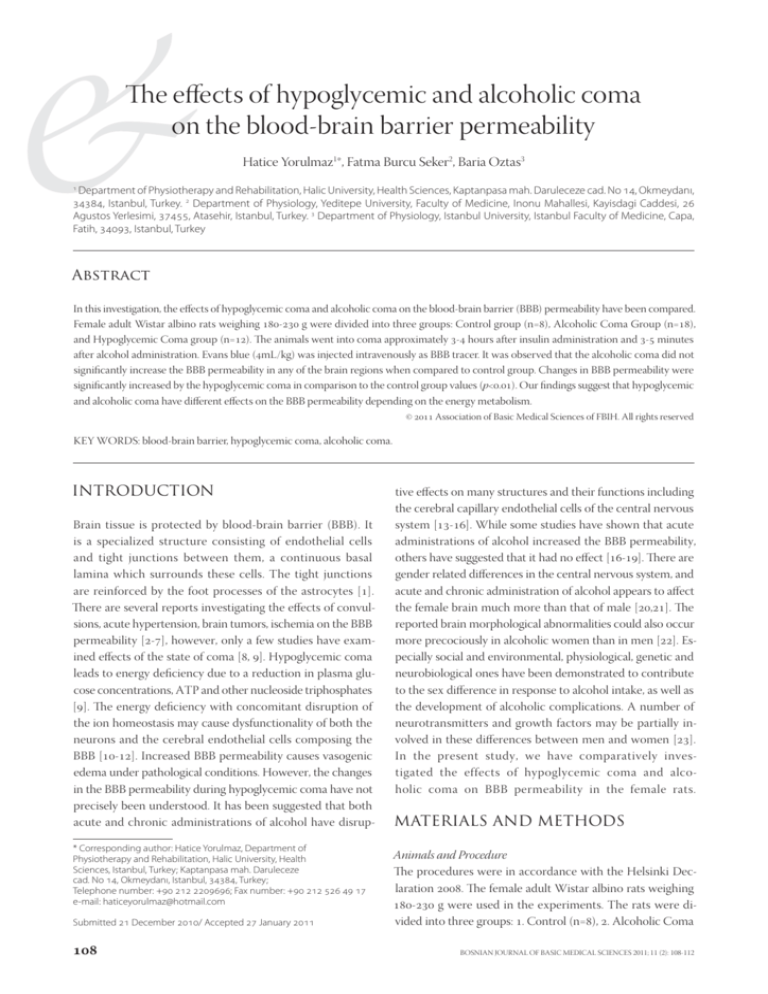
The effects of hypoglycemic and alcoholic coma
on the blood-brain barrier permeability
Hatice Yorulmaz1*, Fatma Burcu Seker2, Baria Oztas3
1
Department of Physiotherapy and Rehabilitation, Halic University, Health Sciences, Kaptanpasa mah. Daruleceze cad. No 14, Okmeydanı,
34384, Istanbul, Turkey. 2 Department of Physiology, Yeditepe University, Faculty of Medicine, Inonu Mahallesi, Kayisdagi Caddesi, 26
Agustos Yerlesimi, 37455, Atasehir, Istanbul, Turkey. 3 Department of Physiology, Istanbul University, Istanbul Faculty of Medicine, Capa,
Fatih, 34093, Istanbul, Turkey
Abstract
In this investigation, the effects of hypoglycemic coma and alcoholic coma on the blood-brain barrier (BBB) permeability have been compared.
Female adult Wistar albino rats weighing - g were divided into three groups: Control group (n=), Alcoholic Coma Group (n=),
and Hypoglycemic Coma group (n=). The animals went into coma approximately - hours after insulin administration and - minutes
after alcohol administration. Evans blue (mL/kg) was injected intravenously as BBB tracer. It was observed that the alcoholic coma did not
significantly increase the BBB permeability in any of the brain regions when compared to control group. Changes in BBB permeability were
significantly increased by the hypoglycemic coma in comparison to the control group values (p<.). Our findings suggest that hypoglycemic
and alcoholic coma have different effects on the BBB permeability depending on the energy metabolism.
© Association of Basic Medical Sciences of FBIH. All rights reserved
KEY WORDS: blood-brain barrier, hypoglycemic coma, alcoholic coma.
INTRODUCTION
Brain tissue is protected by blood-brain barrier (BBB). It
is a specialized structure consisting of endothelial cells
and tight junctions between them, a continuous basal
lamina which surrounds these cells. The tight junctions
are reinforced by the foot processes of the astrocytes [].
There are several reports investigating the effects of convulsions, acute hypertension, brain tumors, ischemia on the BBB
permeability [-], however, only a few studies have examined effects of the state of coma [, ]. Hypoglycemic coma
leads to energy deficiency due to a reduction in plasma glucose concentrations, ATP and other nucleoside triphosphates
[]. The energy deficiency with concomitant disruption of
the ion homeostasis may cause dysfunctionality of both the
neurons and the cerebral endothelial cells composing the
BBB [-]. Increased BBB permeability causes vasogenic
edema under pathological conditions. However, the changes
in the BBB permeability during hypoglycemic coma have not
precisely been understood. It has been suggested that both
acute and chronic administrations of alcohol have disrup* Corresponding author: Hatice Yorulmaz, Department of
Physiotherapy and Rehabilitation, Halic University, Health
Sciences, Istanbul, Turkey; Kaptanpasa mah. Daruleceze
cad. No 14, Okmeydanı, Istanbul, 34384, Turkey;
Telephone number: +90 212 2209696; Fax number: +90 212 526 49 17
e-mail: haticeyorulmaz@hotmail.com
Submitted 21 December 2010/ Accepted 27 January 2011
tive effects on many structures and their functions including
the cerebral capillary endothelial cells of the central nervous
system [-]. While some studies have shown that acute
administrations of alcohol increased the BBB permeability,
others have suggested that it had no effect [-]. There are
gender related differences in the central nervous system, and
acute and chronic administration of alcohol appears to affect
the female brain much more than that of male [,]. The
reported brain morphological abnormalities could also occur
more precociously in alcoholic women than in men []. Especially social and environmental, physiological, genetic and
neurobiological ones have been demonstrated to contribute
to the sex difference in response to alcohol intake, as well as
the development of alcoholic complications. A number of
neurotransmitters and growth factors may be partially involved in these differences between men and women [].
In the present study, we have comparatively investigated the effects of hypoglycemic coma and alcoholic coma on BBB permeability in the female rats.
MATERIALS AND METHODS
Animals and Procedure
The procedures were in accordance with the Helsinki Declaration . The female adult Wistar albino rats weighing
- g were used in the experiments. The rats were divided into three groups: . Control (n=), . Alcoholic Coma
BOSNIAN JOURNAL OF BASIC MEDICAL SCIENCES 2011; 11 (2): 108-112
HATICE YORULMAZ ET AL.: THE EFFECTS OF HYPOGLYCEMIC AND ALCOHOLIC COMA ON THE BLOODBRAIN BARRIER PERMEABILITY
TABLE 1. Values of arterial blood pressure, blood glucose levels and Evans
(n=) and . Hypoglycemic Coma (n=)
blue albumin extravasation, before and after coma.
group. A cannulation was performed to the
Rapoport criteria
Mean Arterial
animals under diethyl-ether anesthesia. FollowDegree of BBB breakdown
Pressure
Blood Glucose
Experimental
n
ing the injection of anesthesia through femoral
Levels (mg/dl)
Groups
Before
After
vein, the femoral artery was catheterized to
0
+1
+2
+3
Coma
Coma
measure systemic arterial blood pressure. BBB
Control
89±3
8
permeability was determined using tracer Evans
(n=8)
blue (EB) (Sigma Cat no: E-) tracer ( mL/
Hypoglycemic
kg, i.v.) []. Alcoholic coma was induced by inComa
89,5±3
85±7
21±2,5
3
2
3
4
jecting g/kg of ethyl alcohol intraperitoneally.
(n=12)
The rats went into coma - minutes after the
Alcoholic
Coma
88±5
87±10
131±43
14
4
alcohol administration []. The animals were
(n=18)
fasted for hours before the experiments but
were allowed free access to water. To induce
the hypoglycemic coma, IU/kg crystallin
zinc insulin (Eli Lily Co, --) was administrated in- RESULTS
traperitoneally under diethyl-ether anesthesia []. The rats
went into coma approximately - hours later following insu- The values of blood pressure, blood glucose and the changes
lin administration. The glucose oxidase method (Accu-Check
in BBB permeability with respect to Rapoport criteria []
Advantage, Roche Diagnostics GmbH, Mannheim, Gerare shown in Table . The baseline mean value of arterial
many) was applied to blood samples drawn from the tails to
blood pressure was .± mmHg for hypoglycemic coma
determine the plasma glucose levels []. Their brains were
group and was ±. mmHg for the alcoholic coma group.
washed by . NaCl perfusion through the left ventricle
No significant change was seen in arterial blood pressure
minutes after the Evans Blue injection. Amount of Evans
values of the rats after they went into hypoglycemic coma
blue penetrating the tissue was evaluated macroscopically
and alcoholic coma (± mmHg, ± mmHg). Plasma
with respect to the Rapoport Criteria []. Staining of each
glucose levels of the rats in alcoholic coma were found to
hemisphere and of coronal sections by Evans blue was gradbe within the normal range (± mg/dl), whereas those
ed as follows: Grade , no staining; Grade +, slight staining;
of rats in hypoglycemic coma were ± . mg/dl (Table ).
Grade +, moderate; and Grade +, marked and dark staining.
It has been observed that the alcoholic coma did not increase
After decapitation, the brain was quickly removed and disthe BBB permeability significantly in any of the brain regions
sected into regions; left cerebral cortex, right cerebral cor- (p>.) when the Evans Blue concentrations in the regions
tex, brain stem and cerebellum. The wet weights of the disof left hemisphere, right hemisphere, cerebellum and the
sected regions were determined. Then, each of the brain area
brain stem (.±., .±., .±., .±. μg/mg
was homogenized in tubes containing mL of N NaOH
tissue respectively) of Alcoholic Coma Group were comand mL of phosphate buffer (. g/L NaHPOHO, .
pared with those of Control Group (.±., .±.,
.±., .±. μg/mg tissue respectively) (Figure ).
g/L NaOH. ml of NaOH and ml of NaHPOHO
were mixed and pH calibrated ,). Following the homogenization, they were centrifuged at rpm for min at
+°C. After centrifuging, each supernatant was transferred
into spectrophotometer tubes and the absorbance values at
nm wave length were read. The Evans blue values were
calculated as mg Evans blue per gram brain tissue by using
the obtained absorbance values, the regression equations and
regression curves of the Evans blue absorbance-amount [].
Statistical analysis
The statistical analysis was made with SPSS (Statistical
Package for Social Sciences . ver.). EB-albumin extravasation was expressed as mean±SEM. Data were compared among groups using one way analysis of variance
FIGURE 1. Displaying quantitative measurements of EB dye con(ANOVA) and subsequently Tukey’s test was performed
tent (% mg) in the brain regions of the groups. *p<0.01 control vs.
where ANOVA showed statistical significance (p<.).
hypoglycemic coma
BOSNIAN JOURNAL OF BASIC MEDICAL SCIENCES 2011; 11 (2): 109-112
HATICE YORULMAZ ET AL.: THE EFFECTS OF HYPOGLYCEMIC AND ALCOHOLIC COMA ON THE BLOODBRAIN BARRIER PERMEABILITY
Contrarily, increased BBB permeability was observed in of
experimental animals that went into hypoglycemic coma
(Table ).
Evans Blue concentrations in the regions of left hemisphere, right hemisphere, cerebellum and the brain stem
(.±., .±., .±., .±. μg/mg tissue respectively) of Hypoglycemic Coma Group were compared with those of Control Group (Figure ). It was determined that hypoglycemic coma increased the BBB
permeability significantly in all of the brain regions (p<.).
DISCUSSION
Glucose is the main substrate the brain uses to generate
energy, which penetrates into the brain by facilitated diffusion through BBB []. Hypoglycemia due to the reduced
plasma glucose levels below normal range leads to brain
dysfunctionalities []. Hypoglycemia is a relatively common condition primarily affecting diabetic patients treated
with insulin or other hypoglycemic drugs and insulinoma
patients. Hypoglycemic effects on the CNS include various
symptoms such as irritability and lack of concentration, disruption of cognitive functions, convulsions and unconsciousness. Even a single hypoglycemic episode with convulsions
and/or coma may, if prolonged and severe enough, cause
permanent degenerative alterations in the cerebral cortex
[]. These symptoms of hypoglycemia suggest the presence
of increased intracranial pressure and cerebral edema [].
In a hypoglycemic coma, neurons and especially cerebral
endothelial cells composing the BBB may face energy failure []. Endothelial cells of brain capillaries differ than the
others with their relatively higher metabolism []. The cerebral capillary endothelial cells have mitochondria in large
quantities [] and contain comparatively -fold more
Na+-K+-ATPase enzymes than the umbilical endothelial
cells []. Hypoglycemia causes the dysfunctionality of active
Na+-K+-ATPases in cerebral endothelial cell membranes due
to the energy deficiency. Due to this dysfunctionality, potassium ions exit and ions like sodium and calcium penetrate
into the cerebral endothelial cells and the cytotoxic edema
occurring as a result of these changes. Thus, it may cause
swelling of the endothelial cells and the tight connections
between them may detach. The vasogenic edema, occurring
as a result of the elevated amount of albumin due to the increased permeability, may be responsible for dysfunctionality of neurons in case of hypoglycemia []. Finally, it can not
be excluded that hypoglycemia has detrimental effects on
mitochondria at the level of the axon, affecting energy production in the axon itself, in the associated Schwann cells,
in the local blood vessels and/or in the perineurial sheath
[]. Sekimoto et al. [] have demonstrated that hypogly-
cemia damaged the endothelial ultrastructure of cerebral
arteries. Hsu and Hedley-Whyte [] have reported that
severe hypoglycemia in mice caused deletion in cerebral
vessel walls. It has also been observed in our study that, the
hypoglycemia coma significantly increased the BBB permeability in the left cortex, right cortex, cerebellum and brain
stem regions of the brain. In addition, lack of any significant
change in arterial blood pressure in rats during the hypoglycemic coma suggests that the blood pressure has no effect
on the increased BBB permeability in case of hypoglycemia.
It has been found that the glucose extraction in the cerebellum is twice more than that of other parts of the brain []
so that the cerebellum conserves the cellular energy better than the cerebral cortex in case of hypoglycemic coma
[, ]. Thus, less BBB damage in the cerebellum has been
reported in comparison to the other parts of the brain [,
]. Similarly, we found less Evans blue-albumin extravasation in the cerebellum when compared to the cerebral cortex.
Alcohol is a soluble substance in both water and oil and can
easily penetrate the lipid membranes of all the cells in the
body. Thus, alcohol can penetrate the BBB easily []. Alcohol could affect the blood flow of the brain, brain glucose metabolism, synthesis and catabolism of various neurotransmitters [-], and also affects many structures and
functions including the capillary endothelial cells in central
nervous system []. In alcoholics, also many physiological dysfunctions occur beside the structural changes in the
brain []. However, the effects of acute alcohol administration on BBB permeability are controversial, there are studies suggesting that alcohol has no effect on BBB permeability beside the studies indicating that alcohol has increased
the BBB permeability against the various tracers [-].
Rossner et al. [], have demonstrated that ethanol
(- g/kg i.v.) increased Evans blue permeability of BBB in
a short term. Similarly, Eriksson et al. [] have administered ethanol ( g/kg i.p.) and have observed increased
BBB permeability in rats. However, Hillbom and Tervo
[] have observed no increase in BBB permeability after
administration of ethanol ( g/kg i.p.) in rats. Effects of
ethanol on BBB permeability have also been studied by using C-sucrose tracer in rats []. They have found that
BBB permeability did not increase when they have administered acutely ethanol as g/kg i.p. Gulati et al. [], using sodium fluorescent as tracer, have injected ethyl alcohol
of , , and as , mg/kg i.v. and consequently
found that the BBB permeability has increased significantly.
They suggested a correlation between alcohol concentration and BBB permeability, and the ethyl alcohol of has
increased the permeability more than the concentrations of
and . However, no change in BBB permeability in rats
has also been reported following administration of ethaBOSNIAN JOURNAL OF BASIC MEDICAL SCIENCES 2011; 11 (2): 110-112
HATICE YORULMAZ ET AL.: THE EFFECTS OF HYPOGLYCEMIC AND ALCOHOLIC COMA ON THE BLOODBRAIN BARRIER PERMEABILITY
nol as g/kg i.p. []. In the present study, ethanol administered at the coma dose ( g/kg) slightly increased the BBB
permeability in only four animals. This discrepancy may be
attributed to the sex of the animals, concentration and administration pattern of alcohol and the difference between
the tracers used for the investigation of BBB permeability.
The effect mechanism of alcohol on BBB permeability
could have been clarified. In contrast to our findings, Haorah et al. [] have shown that the alcohol caused deformation of integrity of BBB by causing the increase in
reactive oxygen types, activation of myosin light chain kinase and the increase in phosphorilation of myosin light
chain and tight connection proteins using primary monolayer human brain microvascular endothelial cell culture.
Alcohol is common cause of coma in all age ranges. Alcoholic coma can be associated with head injuries, hypothermia and the presence of other drugs with which
its action may be additive. In most cases, coma caused
by alcohol will resolve relatively rapidly, the exception being when there is hepatic insufficiency [].
Excessive alcohol short- or long-term health effects
NMDA receptors start to become unresponsive, slowing areas of the brain they are responsible for. Contributing to this effect is the activity which alcohol induces in the
gamma-aminobutyric acid system. The GABA system is
known to inhibit neural activity in the brain. GABA could
also be responsible for the memory impairment [, ].
The effects of alcohol on the BBB permeability need to
be further elucidated. Since BBB damage may lead to
neuroinflammation and neuronal loss, it may be important to establish how BBB affected by alcoholic coma.
In this study, we have shown that hypoglycemic coma
significantly increases the BBB permeability whereas alcoholic coma causes insignificant catabolism of BBB. The
blood glucose level was not affected in alcoholic coma.
Therefore, the energy level seems to be sufficient to maintain the structural integrity of the BBB. However, in hypoglycemic coma the blood glucose level was very low
for providing the essential energy for BBB integrity.
CONCLUSION
Results of the present study suggest that both hypoglycemic and alcoholic coma have different effects on the
BBB permeability depending on the energy metabolism.
DECLARATION OF INTEREST
Authors do not have any commercial affiliations, or potential
conflicts of interest associated with this work submitted for
publication.
BOSNIAN JOURNAL OF BASIC MEDICAL SCIENCES 2011; 11 (2): 111-112
ACKNOWLEDGEMENT
The authors would like to thank to Professor Bayram Yilmaz
of Yeditepe University, Medical School, Department of Physiology in Istanbul for reading and improving the language of
the manuscript.
REFERENCES
[] Chaudhuri JD. Blood brain barrier and infection. Med Sci Monit
; (): -.
[] Bolwig TG, Hertz MM, Westergaard E. Acute hypertension causing blood-brain barrier breakdown during epileptic seizures. Acta
Neurol Scand ; (): -.
[] Brooks DJ, Beaney RP, Lammertsma AA, Leenders KL, Horlock PL,
Kensett MJ, et al. Quantitative measurement of blood-brain barrier
permeability using rubidium- and positron emission tomography. J Cereb Blood Flow Metab ; (): -.
[] Lo EH, Pan Y, Matsumoto K, Kowall NW. Blood-brain barrier disruption in experimental focal ischemia: comparison between in
vivo MRI and immunocytochemistry. Magn Reson Imaging ;
(): -.
[] Oztas B, Kucuk M. Influence of acute arterial hypertension on
blood-brain barrier permeability in streptozocin-induced diabetic
rats. Neurosci Lett ; (): -.
[] Petito CK, Schaefer JA, Plum F. Ultrastructural characteristics of
the brain and blood-brain barrier in experimental seizures. Brain
Res ; (): -.
[] Sadoshima S, Fujishima M, Ogata J, Ibayashi S, Shiokawa O, Omae
T. Disruption of blood-brain barrier following bilateral carotid artery occlusion in spontaneously hypertensive rats, A quantitative
study. Stroke ; (): -.
[] Berbel-Garcia A, Porta-Etessam J , Martinez-Salio A, Ballesta F,
Saiz-Diaz RA , Perez-Martinez DA, et al. Transient cerebral oedema associated to hypoglycemia. Rev Neurol ; (): .
[] Gisselsson L, Smith ML, Siesjo BK. Influence of hypoglycemic
coma on brain water and osmolality. Exp Brain Res ; : .
[] Agardh CD, Siesjo BK. Hypoglycemic brain injury: phospholipids,
free fatty acids, and cyclic nucleotides in the cerebellum of the rat
after and minutes of severe insulin-induced hypoglycemia. J
Cereb Blood Flow Metab ; (): -.
[] Chapman AG, Westerberg E, Siesjo BK. The metabolism of purine
and pyrimidine nucleotides in rat cortex during insulin-induced
hypoglycemia and recovery. J Neurochem ; (): -.
[] Katsura K, Folbergrova J, Bengtsson F, Kristian T, Gido G, Siesjo
BK. Recovery of mitochondrial and plasma membrane function following hypoglycemic coma: coupling of ATP synthesis,
K+ transport, and changes in extra- and intracellular pH. J Cereb
Blood Flow Metab ; (): -.
[] Karwacka H. Ultrastructural and biochemical studies of the brain
and other organs in rats after chronic ethanol administration. I.
Electronmicroscopic investigations of the morphologic elements
of the blood-brain barrier in the rat after ethanol intoxication. Exp
Pathol (Jena). ; (): -.
[] Mayhan WG. Responses of cerebral arterioles during chronic ethanol exposure. Am J Physiol ; (Pt): -.
[] Mayhan WG, Didion SP. Acute effects of ethanol on responses of
cerebral arterioles. Stroke ; (): -.
[] Phillips SC. Does ethanol damage the blood--brain barrier? J Neurol Sci ; : -.
[] Elmas I, Küçük M, Kalaycı RB, Çevik A, Kaya M. Effects of profound hypothermia on the blood-brain barrier permeability in
acute and chronically ethanol treated rats. Forensic Sci Int ;
(): -.
HATICE YORULMAZ ET AL.: THE EFFECTS OF HYPOGLYCEMIC AND ALCOHOLIC COMA ON THE BLOODBRAIN BARRIER PERMEABILITY
[] Gulati A, C. Nath, Shanker K, Srimal RC, Dhawan KN, Bhargava
KP. Effects of alcohols on the permeability of blood-brain barrier.
Pharmacol Res Commun ; : -.
[] Oztas B, Kucuk M. Hypertension-ınduced protein leakage ın the
brain ın chronic ethanol administered rats. Pharmacol Res Commun ; (): -.
[] Kril JJ, Halliday GM. Brain shrinkage in alcoholics: A decade on
and what have we learned? Prog Neurobiol ; (): -.
[] Schindler CJ, Veliskova J, Slamberova R, Vathy I. Prenatal morphine exposure alters susceptibility to bicuculline seizures in a sexand age-specific manner. Brain Res Dev Brain Res ; ():
-.
[] Limosin F. Clinical and biological specificities of female alcoholism.
Encephale. ;():-
[] Ceylan-Isik AF, McBride SM, Ren J. Sex difference in alcoholism:
who is at a greater risk for development of alcoholic complication?
Life Sci. ;(-):-.
[] Cherian L, Mathew J, Klemm WR. Ethanol-induced hydrolysis of
brain sialoglycoconjugates in the rat: effect of sialic acid in antagonizing ethanol intoxication. Alcohol Clin Exp Res. ;():.
[] Oztaş B, Camurcu S. Blood-brain barrier permeability after electrically induced seizure in normoglycemic, hypoglycemic, and hyperglycemic rats. Psychiatry Res. ;():-.
[] Barham D, Trinder P. An improved colour reagent for the determination of blood glucose by the oxidase system. Analyst.
;():-
[] Rapoport SI, Fredericks WR, Ohno K, Pettigrew KD. Quantitative
aspects of reversible osmotic opening of the blood-brain barrier.
Am J Physiol ; (): -.
[] Gjedde A, Rasmussen M. Blood-brain glucose transport in the conscious rat: comparison of the intravenous and intracarotid injection methods. J Neurochem ; : -.
[] Gerich JE, Mokan M, Veneman T, Korytkowski M, Mitrakou A.
Hypoglycemia unawareness. Endocr Rev ; : -.
[] Mohseni S. Hypoglycemic neuropathy. Acta Neuropathol ;
:–.
[] Plum F, Posner JB. Metabolic brain diseases causing coma, In: Diagnosis of Stupor and Coma, rd edn Philadelphia: FA Davis Co. ,
pp. .
[] Hsu DW, Hedley-Whyte ET. Effects of insulin-induced hypoglycemia on cerebrovascular permeability to horseradish peroxidase. J
Neuropathol Exp Neurol. ; (): -.
[] Mrsulja BB, Djuricic BM. Biochemical characteristics of cerebral
capillaries. Adv Exp Med Biol ; : -
[] Oldendorf WH, Cornford ME, Brown WJ. The large apparent
work capability of the blood-brain barrier: a study of the mitochondrial content of capillary endothelial cells in brain and other tissues
of the rat. Ann Neurol ; (): -.
[] Eisenberg HM, Suddith RL. Cerebral vessels have the capacity to
transport sodium and potassium. Science ; (): .
[] Arieff AI, Doerner T, Zelig H, Massry SG. Mechanisms of seizures
and coma in hypoglycemia. Evidence for a direct effect of insulin
on electrolyte transport in brain. J Clin Invest ; (): -.
[] Sekimoto H, Shimada O, Matsutani Y, Nakanish T, Nakano T,
Katayama O. Influence of insulin-induced hypoglycemia on ultrastructure of cerebral arterial endothelium. J Cereb Blood Flow
Metab ; (): -.
[] LaManna JC, Harik SI. Regional comparisons of brain glucose influx. Brain Res. ; (): -.
[] Ratcheson RA, Blank AC, Ferrendelli JA. Regionally selective metabolic effects of hypoglycemia in brain. J Neurochem ; ():
-.
[] Kaya M, Kucuk M, Kalayci RB, Cimen V, Gurses C, Elmas I et al.
Magnesium sulfate attenuates increased blood-brain barrier permeability during insulin-induced hypoglycemia in rats. Can J Physiol Pharmacol. ; (): -.
[] Janigro D. Blood-brain barrier, ion homeostasis and epilepsy: possible implications towards the understanding of ketogenic diet
mechanisms. Epilepsy Res. ; (): -.
[] Altura BM, Altura BT. Association of alcohol in brain ınjury, headaches, and stroke with brain-tissue and serum levels of ıonized
magnesium: a review of recent findings and mechanisms of action.
Alcohol ; (): -.
[] Charness ME, Simon RP, Greenberg DA. Ethanol and the nervous
system. N Engl J Med ; (): -.
[] Lyons D, Miller MD, Hedgecock-Rowe AA, Craine AM, Porrino
LJ. Time-dependent effects of acute ethanol administration on regional cerebral blood flow in the rat. Alcohol ; (): -.
[] Rossner W, Nusstein R. Alcohol and the blood-brain barrier.
Zentralbl Veterinarmed A. ; (): -.
[] Eriksson T, Carlsson A, Liljequist S, Hagman M, Jagenburg R. Decrease in plasma amino acids in rat after acute administration of
ethanol. J Pharm Pharmacol ; : -.
[] Hillbom ME, Tervo TM. Ethanol and acetaldehyde do not increase
the blood-brain and blood-retinal barrier permeability to sodium
fluorescein. Experientia ; : -.
[] Haorah J, Knipe B, Leibhart J, Ghorpade A, Persidsky Y. Alcoholinduced oxidative stress in brain endothelial cells causes bloodbrain barrier dysfunction. J Leukoc Biol. ; : -.
[] Gaw A, Murphy MJ, Cowan R, O'Reilly D, Stewart M, Shepherd
J. Coma. In; Gaw A (ed) Clinical Biochemistry, th edn. Churchill
Livingstone Elsevier; , pp. .
[] Hanchar HJ, Chutsrinopkun P, Meera P, Supavilai P, Sieghart W,
Wallner M, Olsen RW. Ethanol potently and competitively inhibits
binding of the alcohol antagonist Ro- to α/βδ GABAA
receptors. Proc Natl Acad Sci U S A. ; (): –.
[] Qiang M, Denny AD, Ticku MK. Chronic intermittent ethanol
treatment selectively alters N-methyl-D-aspartate receptor subunit
surface expression in cultured cortical neurons. Mol Pharmacol
; (): –.
BOSNIAN JOURNAL OF BASIC MEDICAL SCIENCES 2011; 11 (2): 112-112

